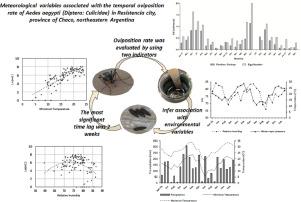Acta Tropica ( IF 2.1 ) Pub Date : 2020-08-24 , DOI: 10.1016/j.actatropica.2020.105678 Javier O Gimenez 1 , Carla N Alvarez 2 , Walter R Almirón 3 , Marina Stein 2

|
Aedes aegypti is the main vector of dengue virus in South America. In the last fifteen years, Argentina has suffered three large dengue outbreaks: one in 2009, another one in 2016 and the current 2020 outbreak, with 26,000, 66,000 and more than 43,000 confirmed cases, respectively. These outbreaks are associated with the circulation of the virus in neighboring countries due to the constant movement of people across the frontier. In 2009, the main province affected was Chaco province, with 11,037 confirmed cases (50% of total cases). Thus, the aim of this study was to characterize the temporal oviposition rate of Aedes aegypti in Resistencia, the capital city of this province, in relation to meteorological variables. Mosquitoes were sampled weekly, from April 2015 to March 2017, using ovitraps located in houses randomly selected within the urban area. Oviposition rate was evaluated by means of the total number of eggs collected per week and the proportion of positive ovitraps per week. The coefficient of variation for these two indicators was estimated for the whole study period and then compared using the Wilcoxon Pair test. A generalized linear model (GLM) was performed to infer association between meteorological variables and oviposition rate without time lag and with a time lag of 1 to 4 weeks, considering the biology of this mosquito species. Comparisons between the coefficient of variation of egg number versus the proportion of positive ovitraps showed significant differences, being the former more variable than the latter. The most significant time lag was 2 weeks for the minimum temperature. The number of Ae. aegypti eggs increased 4.05 times when the minimum temperature increased 1°C two weeks before, and decreased 0.69 times with an increase of 1 unit in relative humidity. No eggs were collected when the temperature was below 8°C. The oviposition rate was associated with the increase in the critical minimum temperature (over 8°C) and the weekly frequency of precipitation and dissociated with relative humidity. The maximum oviposition rate was recorded between November and January of both years. The GLM could not explain the relation between meteorological variables and the proportion of positive ovitraps. The peaks of Ae. aegypti egg abundance occurred simultaneously with dengue autochthonous cases recorded in Chaco province, resulting in a good indicative of the period of greatest epidemiological risk.
中文翻译:

与阿根廷东北部查科省抵抗抵抗城市埃及伊蚊(产双翅目:蚊科)的时间产卵率相关的气象变量。
埃及伊蚊是南美登革热病毒的主要载体。在过去的15年中,阿根廷遭受了3次大规模登革热暴发:一次在2009年爆发,另一次在2016年爆发,在目前的2020年爆发,确诊病例分别为26,000起,66,000起和43,000起。由于人们不断地穿越边境,这些暴发与病毒在邻国的传播有关。2009年,受影响的主要省是查科省,确诊病例为11,037例(占总病例的50%)。因此,本研究的目的是表征埃及伊蚊的产卵率与气象变量相关的省份首府抵抗抵抗运动(Resistencia)。从2015年4月至2017年3月,每周使用市区内随机选择的房屋中的产卵器取样蚊子。产卵率通过每周收集的卵子总数和每周阳性卵子捕获的比例进行评估。在整个研究期间估算这两个指标的变异系数,然后使用Wilcoxon Pair检验进行比较。考虑到该蚊种的生物学特性,进行了广义线性模型(GLM)来推断气象变量与产卵率之间的关联,且不存在时间滞后和1至4周的时间滞后。卵数变异系数与阳性卵母细胞比例之间的比较显示出显着差异,前者比后者更具可变性。对于最低温度,最明显的时间滞后是2周。的数量e 最低温度在两周前升高1°C时,埃及产卵增加4.05倍,相对湿度每增加1个单位,埃及产卵减少0.69倍。当温度低于8℃时,没有收集到卵。产卵率与临界最低温度(超过8°C)的升高和每周的降水频率增加有关,并且与相对湿度无关。最高产卵率记录在两年的十一月和一月之间。GLM无法解释气象变量与阳性产卵器比例之间的关系。Ae的山峰。埃及 查科省记录的登革热本地病例同时发生了鸡蛋丰度,从而很好地表明了流行病风险最高的时期。











































 京公网安备 11010802027423号
京公网安备 11010802027423号